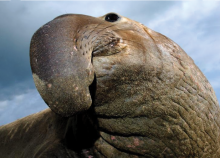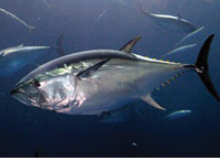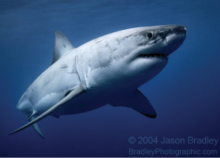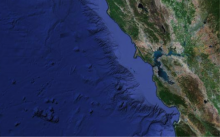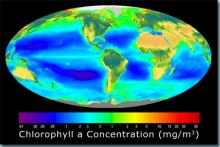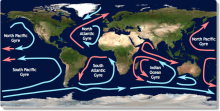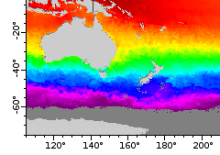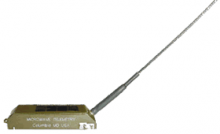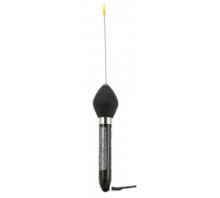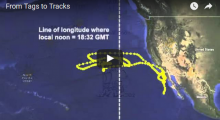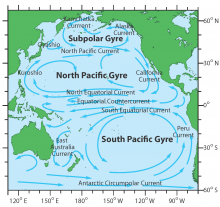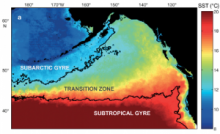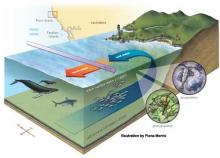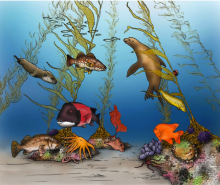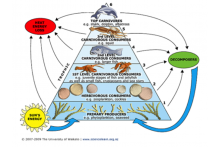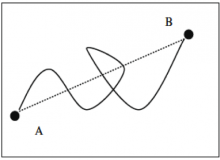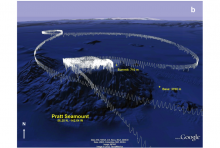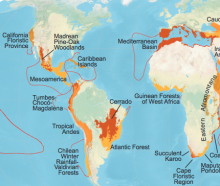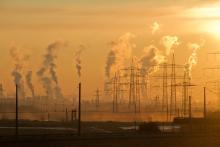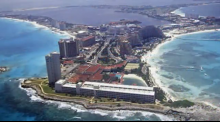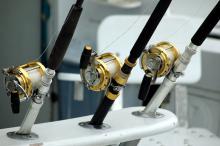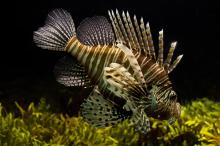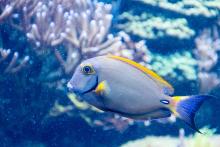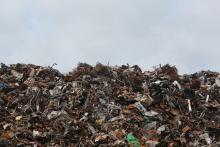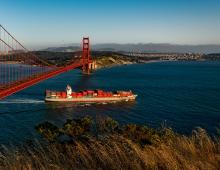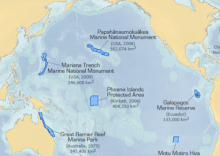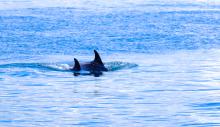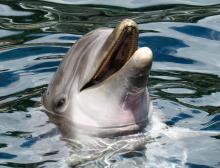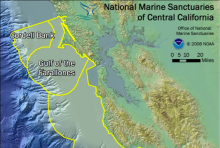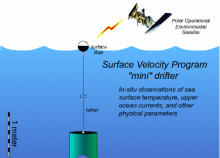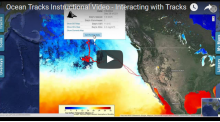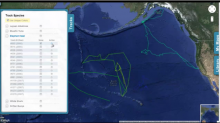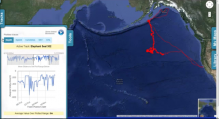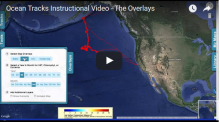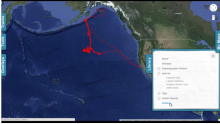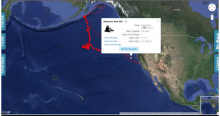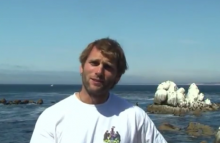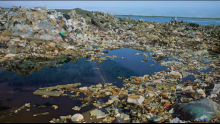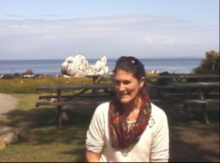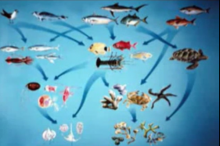The Library
|
Elephant Seal Species Elephant seals are the largest seals on earth. Males grow to over 13 feet long and weigh up to 4,500 pounds. Females are slightly smaller, measuring up to 10 feet in length and... |
|
|
Laysan Albatross Species Laysan albatross are seabirds, meaning they spend most of their lives at sea. Albatross are the largest of the sea birds and one of the worlds most accomplished fliers.... |
|
|
Northern Bluefin Tuna Species Bluefin tuna are some of the fastest fish in the sea. They have streamlined bodies and can even retract their dorsal and pectoral fins to reduce drag in the... |
|
|
White Shark Species White sharks are the largest predatory sharks, and the occasional encounter with humans has made them the most famous. Although they can reach almost 7 m in length, the average shark... |
|
|
Bathymetry Oceanographic Factors Bathymetry is the measurement of depth of water in oceans, seas, or lakes. How is bathymetry represented in the Ocean Tracks map? The bathymetry data layer... |
|
|
Chlorophyll Oceanographic Factors Chlorophyll is a green pigment, present in all green plants and in cyanobacteria, responsible for the absorption of light to provide energy for... |
|
|
Ocean Currents Oceanographic Factors Wind is the primary force driving surface currents in the ocean. The sun heats the surface of the earth unevenly because of the shape and tilt... |
|
|
Sea Surface Temperature Oceanographic Factors Sea surface temperature (SST) is the water temperature close to the ocean's surface. The exact meaning of surface varies... |
|
|
Archival Tag Tags Data storage or archival tags have been used extensively to study large-scale movement and behavioral patterns of marine fish, reptiles, birds and mammals. In the past 5 years, rapid... |
|
|
Satellite Telemetry Tags Tags The term “satellite telemetry tag” is used broadly to describe electronic tags which use Earth-orbiting satellite systems, like GPS or Argos, to determine their... |
|
|
Pop-up satellite archival tags (PSATs) Tags Pop-up satellite archival tags (PSATs) are satellite tags and archival tags combined in the same package. Their major advantage is that... |
|
|
Smart Position and Temperature (SPOT) Transmitting Tags Tags Smart Position and Temperature (SPOT) Transmitting tags are perfect for studying species that spend... |
|
|
From Tags to Tracks Tags This video explains how tags are used for tracking animals. |
|
|
Major Currents The North Pacific Ocean Gyres are large rotating current systems in the ocean. The motion of gyres is determined by the direction of the prevailing winds and the... |
|
|
The North Pacific Transition Zone and Transition Zone Chlorophyll Front The North Pacific Ocean The region of the ocean where... |
|
|
Upwelling and the California Current The North Pacific Ocean The California current is the eastern boundary current of the North Pacific Gyre, running southward... |
|
|
General Ecology Introduction General Ecology The oceans of our planet cover approximately 70% of the Earth’s surface. The Pacific Ocean is the largest of all ocean basins, covering... |
|
|
Levels of Organization in Ecology General Ecology Stretching from 8 kilometers above the Earth’s surface and diving deep as far as 11 kilometers below the surface of the... |
|
|
Energy and Food Webs General Ecology All living things require energy in order to survive and carry out their life processes, such as growth, reproduction and for their metabolism. For... |
|
|
The Curviness Tool The Curviness Tool The curviness number is calculated by dividing the distance along the path from point A to point B (solid line) by the straight-line distance between point A and... |
|
|
Biological Hotspots in Ocean Tracks Hotspots Biodiversity hotspots are areas that are used by many different species. In other words, these areas have high biological diversity. |
|
|
Biodiversity Hotspots in Conservation Hotspots Biodiversity is the variety of life on earth. Biodiversity is most simply thought of as the number of species found on earth,... |
|
|
The Hotspot Tool Hotspots The hotspot tool we use in Ocean Tracks measures the density of points in a particular area. The higher the density of points, the more red the area appears. The lower the density... |
|
|
Climate Change Human Impacts The term climate is used to describe weather conditions (including average and extreme conditions) over a long time period. The sun is the primary source of energy... |
|
|
Coastal Development Human Impacts The number of people living on the coasts has rapidly increased in recent decades, causing significant development of coastal areas. Coastal development... |
|
|
Fishing Human Impacts Humans have relied on resources from the ocean since the beginnings of human existence on the planet. Population growth has increased demand for fishery species, which in... |
|
|
Human Impacts Map Human Impacts Scientists have recently generated a map that shows the intensity of human impacts in the ocean (http://www.nceas.ucsb.edu/globalmarine). The colors on this... |
|
|
Invasive Species Human Impacts Invasive species are non-native to a particular region, and negatively impact native species through interactions such as predation and competition. ... |
|
|
Ocean Acidification Human Impacts The ocean plays an important role in regulating the amount of carbon dioxide in the atmosphere. The ocean absorbs about a quarter of the carbon dioxide... |
|
|
Oil Extraction Human Impacts Oil extraction activities can negatively effect marine organisms by destroying ocean habitat and by releasing oil and other pollutants into the marine environment... |
|
|
Pollution Human Impacts Human activities along the coast and in open ocean areas can result in the addition of chemicals, particles, and other waste materials into the marine environment. ... |
|
|
Shipping Human Impacts Cargo ships negatively impact the marine environment in a number of ways, including through the release of pollutants, animal strikes, carbon emissions, and the distribution of... |
|
|
Marine Protected Areas Introduction Marine Protected Areas If you have ever been to Acadia, Yellowstone or some other national park, then you have been to a geographic area that has been... |
|
|
Purpose and Benefits of Marine Protected Areas Marine Protected Areas Marine Protected Areas are established with one of three objectives in mind. To conserve natural heritage... |
|
|
Establishing Marine Protected Areas Marine Protected Areas When determining the location of a MPA, there are some characteristics of the site to consider: areas that are... |
|
|
The Social Dimensions of MPAs Marine Protected Areas Human interactions with the ocean are important economically, socially, culturally, and spiritually. Marine policy makers,... |
|
|
Types and Design of Marine Protected Areas Marine Protected Areas Examples of Marine Protected areas include, marine reserves, marine sanctuaries, national parks and... |
|
|
Drifters Drifters “Drifters” are freely-floating drifting buoys that are deployed in the ocean to measure currents. The drifter is composed of a surface float, a tether and a drogue. There are some variations on... |
|
|
Overview Video Video Tutorials An overview video of the Ocean Tracks interface. |
|
|
The Tracks Video Tutorial Video Tutorials This video explains how to use the Tracks overlay. |
|
|
The Tools Video Tutorial Video Tutorials This video explains how to use the tools in the Ocean Tracks interface. |
|
|
The Overlays Video Tutorial Video Tutorials This video explains how to use the overlays in the Ocean Tracks interface. |
|
|
The Library Video Tutorial Video Tutorials Learn how to access the Library, which has resources related to Ocean Tracks, in the video tutorial. |
|
|
Interacting with Tracks on the Map Video Tutorial Video Tutorials Learn how the tools and overlays interact with the animals tracks in this video tutorial. |
|
|
Scientist Video: Taylor Chapple – Background Scientist Videos Meet scientist Taylor Chapple and learn how he became a marine biologist studying white sharks. ... |
|
|
Scientist Video: Taylor Chapple – Tagging White Sharks Scientist Videos How do scientists tag sharks for research? Learn more in this video. |
|
|
Scientist Video: Taylor Chapple – Conservation Scientist Videos In this video, scientist Taylor Chapple explains why the conservation and protection of sharks is... |
|
|
Scientist Video: Sara Maxwell – Career Scientist Videos Meet scientist Sara Maxwell. Hear how she found her career path. |
|
|
Scientist Video: Sara Maxwell – Predators Scientist Videos Scientist Sara Maxwell describes why predators are so important to ecosystems. |
|
|
Scientist Video: Sara Maxwell – Conservation Scientist Videos How can we protect animals? Scientist Sara Maxwell discusses a few conservation methods. |
|
|
Scientist Video: Meet Elliott Hazen Scientist Videos Meet Elliott Hazen and hear how he became involved with animal tracking research and what we know from this research. |
|

